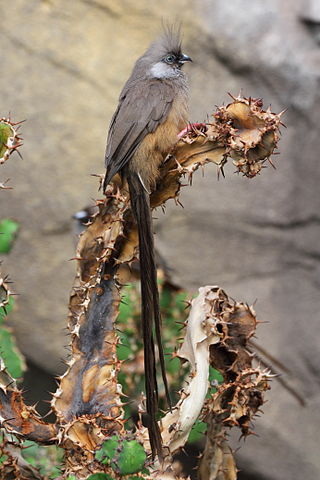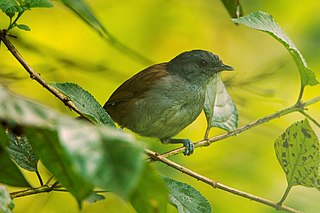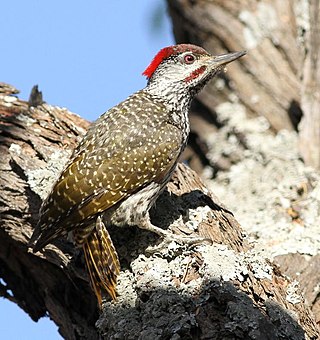
The speckled mousebird is the largest species of mousebird, as well as one of the most common. It is found throughout most of Central, Eastern and Southern Africa.

The African firefinch, also called the blue-billed firefinch, is a common species of estrildid finch found in many parts of Africa. It has an estimated global extent of occurrence of 5,400,000 km2 (2,100,000 sq mi).

The grey-headed kingfisher is a species of kingfisher that has a wide distribution from the Cape Verde Islands off the north-west coast of Africa to Mauritania, Senegal and Gambia, east to Ethiopia, Somalia and southern Arabia and south to South Africa.

The African pipit is a fairly small passerine bird belonging to the pipit genus Anthus in the family Motacillidae. It is also known as the grassveld pipit or grassland pipit. It was formerly lumped together with the Richard's, Australian, mountain and paddyfield pipits in a single species, Richard's pipit, but is now often treated as a species in its own right.

The African yellow warbler, also known as Natal yellow warbler, dark-capped yellow warbler or yellow flycatcher-warbler, is a species of Acrocephalidae warblers; formerly, these were placed in the paraphyletic "Old World warblers".

The green-capped eremomela or greencap eremomela is a species of bird formerly placed in the "Old World warbler" assemblage, but now placed in the family Cisticolidae.

The African green pigeon is a species of bird in the family Columbidae, and one of 5 green pigeon species in the Afrotropics. The species has a wide range in Sub-Saharan Africa with around 17 accepted races.

The rattling cisticola is a species of bird in the family Cisticolidae which is native to Africa south of the equator, and parts of East Africa. It is a common to abundant species in open savanna and scrubland habitats, whether in arid, moist or upland regions. Especially during summer, it is highly conspicuous due to its strident and repetitive call-notes from prominent perches.

The white-browed scrub robin, also known as the red-backed scrub-robin, is a species of bird in the family Muscicapidae. It is native to sub-Saharan Africa, especially East and southern Africa. Within range, its Turdus-like song is one of the often-heard sounds of the bush. The flitting of the tail is characteristic of this species, but also of some near relatives.

The mocking cliff chat, mocking chat or cliff chat, is a species of chat in the family Muscicapidae which occurs in rocky habitats in much of eastern Sub-Saharan Africa.
The Abyssinian catbird or juniper babbler is a species of bird in the family Sylviidae.. It is endemic to Ethiopia where it is found in highland forest and scrub. The Abyssinian catbird is a fairly small, mostly grey bird with black lores, whitish forehead and chestnut vent.

The baglafecht weaver is a species of weaver bird from the family Ploceidae which is found in eastern and central Africa. There are several disjunct populations with distinguishable plumage patterns. Only some races display a discrete non-breeding plumage.

Pseudoalcippe is a genus of passerine birds in the family Sylviidae that are found in Africa.

The African broadbill, also known as the black-capped broadbill or Delacour's broadbill, is a species of bird in the sub-oscine family Calyptomenidae.

The arrow-marked babbler is a species of bird in the family Leiothrichidae. It is native to woodlands in the southern Afrotropics.

The northern yellow white-eye, formerly the African yellow white-eye, is a species of bird in the family Zosteropidae. It is found across sub-Saharan Africa, from Senegal in the west across to southern Sudan in the east and south to northern Angola.

The golden-tailed woodpecker is a species of bird in the family Picidae. Its specific name commemorates the 5th Earl of Abingdon. It belongs to a species complex that includes the Knysna woodpecker to the south of its range, and the mostly allopatric Mombasa woodpecker to the northeast, with which it perhaps hybridizes.
The dark batis is a small passerine bird belonging to the genus Batis in the wattle-eye family, Platysteiridae. It is found in highland forest in south-west Tanzania, northern Malawi, and northern Mozambique. These birds were formerly thought to be forest batises but in 2006 were described as a new species based on differences in morphology and mitochondrial DNA from those birds in northern Tanzania and Kenya.

The cinnamon-breasted tit is passerine bird in the family Paridae. It is found in Tanzania, Malawi, Mozambique and Zimbabwe. Its natural habitat is miombo woodland.

The southern yellow white-eye is a bird species in the family Zosteropidae. It is found in parts of southern Africa. It was formerly considered conspecific with the African yellow white-eye.



















